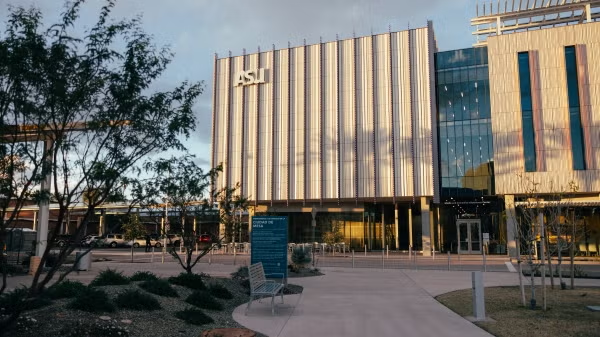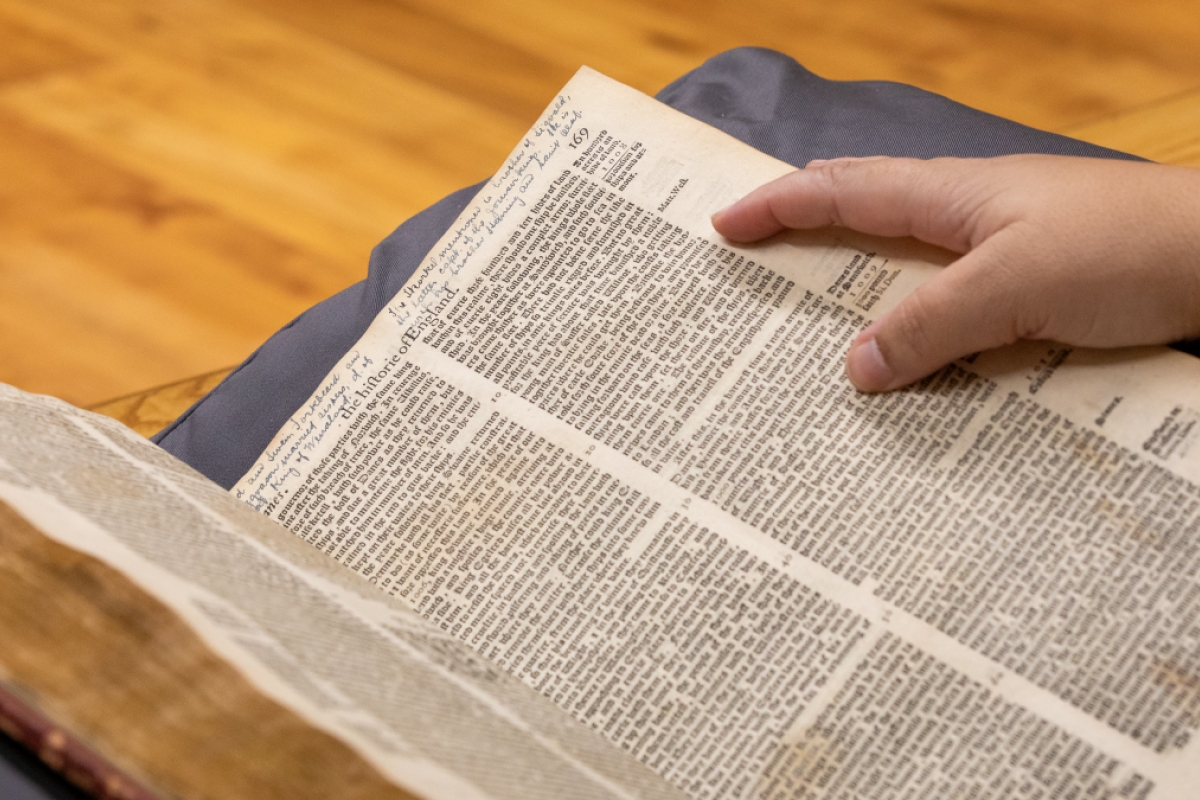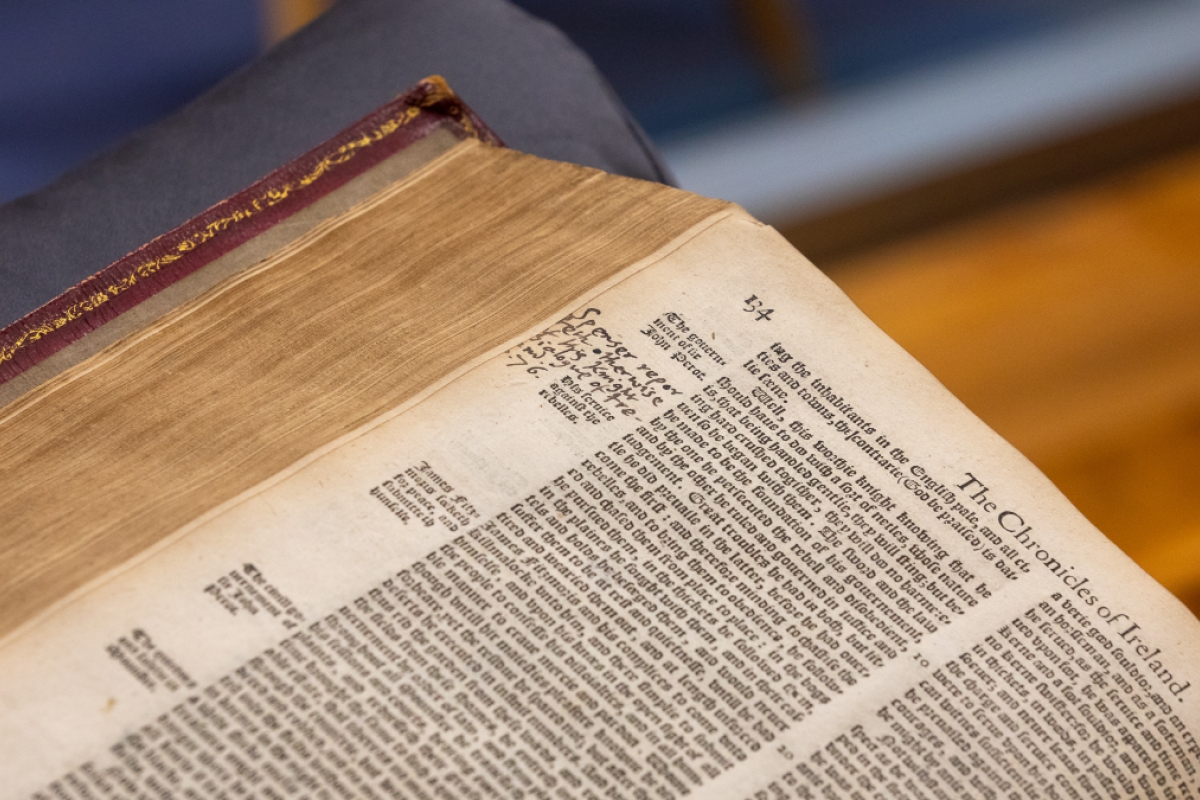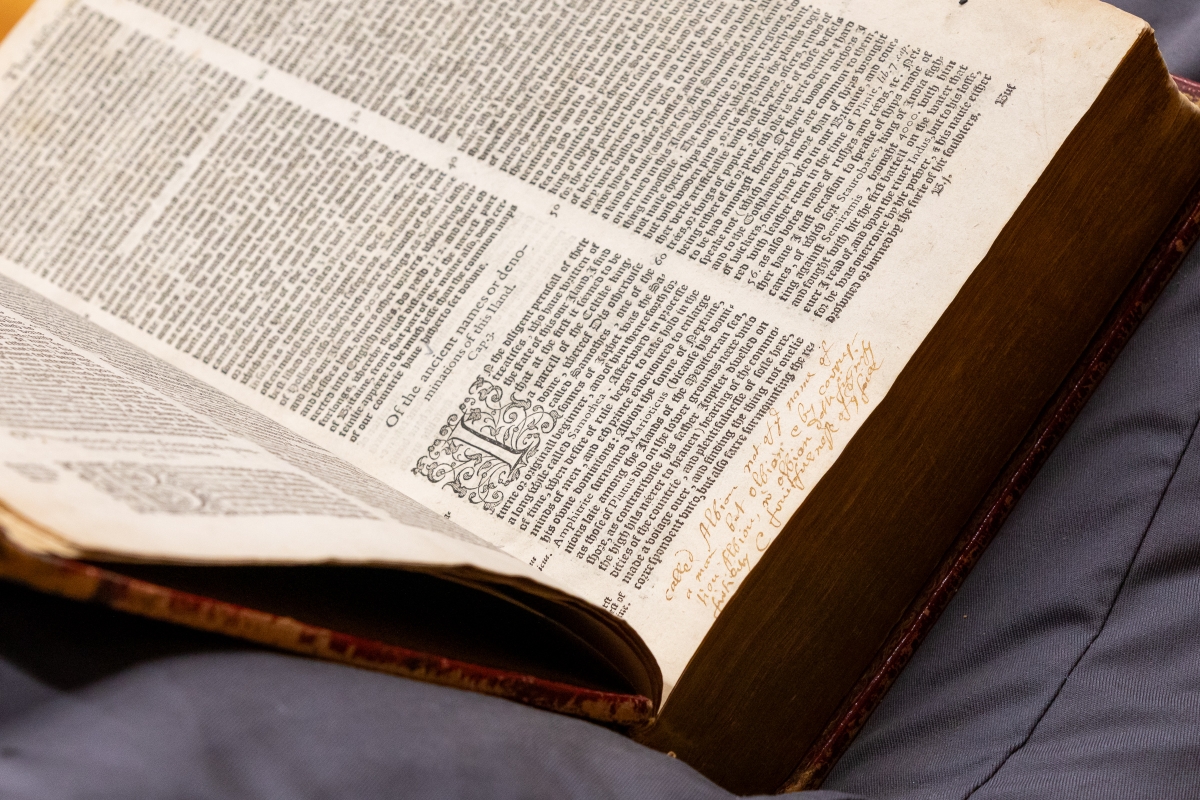An ASU-led rare book find

Brandi Adams, an assistant professor in Arizona State University's Department of English, looks through the 1587 copy of "Holinshed's Chronicles" found in Burton Barr Central Library in Phoenix. The book is just one of three known English-lanugage books with the handwriting of poet John Milton. Photo by Bruce Matsunaga/ASU Department of English
Editor’s note: This story is featured in the 2024 year in review.
Aaron Pratt began to look through the 1587 copy of "Holinshed’s Chronicles."
It was mid-morning, March 1, and Pratt, the Pforzheimer Curator at the University of Texas at Austin's Harry Ransom Center, was one of four visiting scholars perusing the Alfred Knight Collection in the Rare Book Room of the Burton Barr Central Library in Phoenix.
Knight, a noted collector, had donated more than 2,000 books to the library upon his death in 1958, and the scholars had been invited there by Brandi Adams, an assistant professor in Arizona State University’s Department of English, and Jonathan Hope, an English professor at ASU.
As Pratt flipped through pages of the book, which served as source material for more than one-third of Shakespeare’s plays, he saw writing in the margins, specifically, a small letter “e” that looked familiar.
He turned around and asked Claire M. L. Bourne, an associate professor of English at Penn State, to take a look.
Bourne was stunned. It would take a few weeks to verify, but they had discovered only the third known English-language book to include the handwritten reading notes of John Milton, the English author of the 1667 poem "Paradise Lost."
Buried treasure. In a Phoenix public library.
This is the story of how that treasure was found.
Cultivating a culture for scholars
In creating the Arizona Book History Group, Adams and Hope wanted to create a different atmosphere for book scholars to do research.
“Generally, book historians and bibliographers have to come in with what Claire describes as surgical precision, see what they need to see and leave,” Adams said. “We don’t get time to kind of meander with a book. So we decided that this would be a good way to think about how do we kind of break some of those structures and work in community and conversation.”
Adams and Hope raised funds for the visiting scholars to spend two mornings — Feb. 29 and March 1 — inside the Rare Book Room. Then, each afternoon, the scholars discussed highlights they found in the collection during a public event in the Ross-Blakley Hall on ASU’s Tempe campus.
Each of the scholars used an Excel spreadsheet to pre-request books from the collection they wanted to see, and when they arrived on the morning of the 29th, Alex Mada, the special collections manager at the library, had set up four desks and trolleys alongside the desks filled with the requested books.
Pratt glanced through "Holinshed’s Chronicles" that morning but didn’t notice anything special. Then, on March 1, he again opened the book, looking for something he could talk about in the public presentation that afternoon.
“One of the things about 'Holinshed’s Chronicles' is that they were subject to several rounds of post-publication censorship,” Pratt said. “There was material in the 'Chronicles' that various folks were not super pumped about. ... Bits were cut out and then replacement leaves had to be put in to sort of bridge the gaps that were created by the censorship. I was looking for evidence of that.”
When Pratt got to page 501 of Volume Three in the 'Chronicles,' he saw the little “e” in the notations.
“I was like, ‘God, there’s no way in hell this is true, but it kind of looks like this stupid way Milton writes 'e,'" Pratt said. “Normally, we’re sort of used to that single stroke kind of lowercase 'e.' But that’s not the way Milton was taught to write an 'e.' He doesn’t know how to do it in one stroke. He does a two-stroke 'e' where he kind of does a 'c'-looking thing and then this other kind of thing to close the loop."
Intrigued, Pratt kept looking. He started seeing scratchy brackets with notations in the margins, brackets that looked very similar to the brackets found in one of the two other known English-language books with Milton’s handwriting, Shakespeare’s "First Folio," identified by Bourne and a collaborator in the Philadelphia Free Library.
(The third book is a 1612 edition of the Bible Milton owned that is kept in the British Library in London).
“I’m sort of sitting across from Aaron and watching him, and he sort of stopped,” Adams said. “The best way I can describe Aaron is that he’s got this sort of expansive, almost photographic kind of memory. So he just stopped, looked up for a second, then looked back down and sort of paused. Then he turned back because Claire was standing behind him and said, ‘I think you need to come and see this.’”
As Bourne started flipping through pages, she opened her computer and pulled up Milton’s annotations found in the Shakespeare folio.
“We’re kind of going back and forth, like, is that double 'l' similar? Is that double 's' similar? We’re just trying to compare individual letter forms because sometimes, when you’re looking at early handwriting, the impression is it’s Milton’s, but to do the comparison, you actually have to compare individual letter forms and combinations of letter forms.”
With all of the scholars now looking on — “everybody was kind of making jokes, saying, ‘Oh, this would just be too ridiculous,'” Hope said — Bourne texted Jason Scott-Warren, director of the Cambridge Centre for Material Texts at the University of Cambridge, pictures of the handwriting and brackets in the book.
It was Scott-Warren who, in September 2019, identified Milton as the annotator of the Shakespeare folio based on Bourne’s research.
Bourne wasn’t sure how Scott-Warren would respond, terming him “very conservative” in making grand pronouncements.
Then the reply text came.
“Wow,” it read. “Bingo.”
Looking forward
Normally, Bourne said, it would take months for scholars to research the handwriting and determine if it was Milton’s. But by inviting the four visiting scholars to visit the Rare Book Room and look through Knight’s collection at the same time, Hope and Adams had unknowingly created a research team.
“If one person had found that, it would have taken ages for her to get around to everyone and say, ‘Oh, I found this. What do you think?’” Hope said. “Because you need to check so many things. There’s the handwriting, for one thing. Does it look like the handwriting we found in other places? You also need to say, ‘What’s the provenance (place of origin) of the book? Does that fit with when we know Milton could have done the handwriting? And what about the content of the annotations? Is it the kind of stuff Milton would have written about in the book?’
“We were able to do all of that pretty quickly.”
Could there be other undiscovered books with Milton’s handwriting? Bourne thinks it’s possible, but when Milton died in 1674, she said, his books weren’t sold or traveled as a collection.
“They scattered, and we don’t know where,” she said. “We don’t have a lot of evidence of where they went.”
But after finding two of the books in public libraries, Hope knows where the search should begin.
“One of the things I think this find is highlighting is that academics probably should be looking beyond university libraries,” he said. “They’ve all focused on private research collections and tend not to go to places like the Phoenix Public Library.”
Adams, Hope and the Arizona Book History Group invited four scholars to the library; and look what happened.
Buried treasure was found.
More Arts, humanities and education

Exceeding great expectations in downtown Mesa
Anyone visiting downtown Mesa over the past couple of years has a lot to rave about: The bevy of restaurants, unique local shops, entertainment venues and inviting spaces that beg for attention from…

Upcoming exhibition brings experimental art and more to the West Valley campus
Ask Tra Bouscaren how he got into art and his answer is simple.“Art saved my life when I was 19,” he says. “I was in a dark place and art showed me the way out.”Bouscaren is an …

ASU professor, alum named Yamaha '40 Under 40' outstanding music educators
A music career conference that connects college students with such industry leaders as Timbaland. A K–12 program that incorporates technology into music so that students are using digital tools to…




